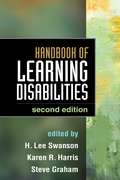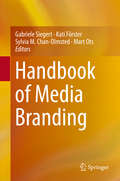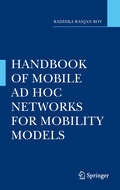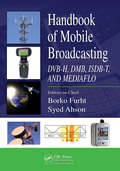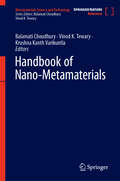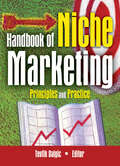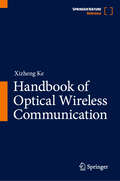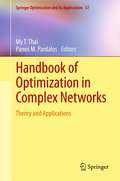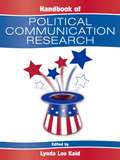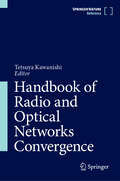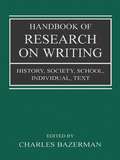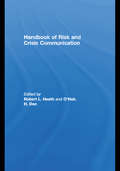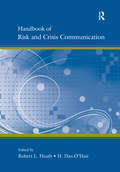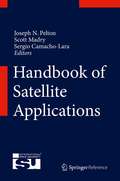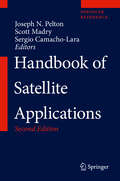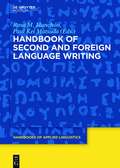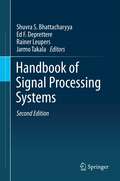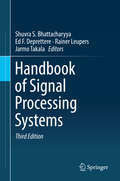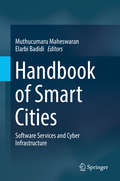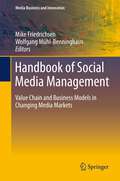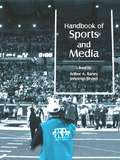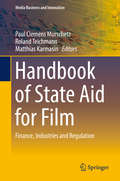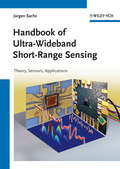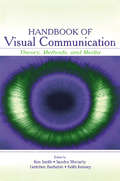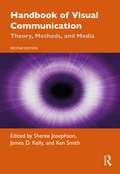- Table View
- List View
Handbook of Learning Disabilities, Second Edition
by Steve Graham Karen R. Harris H. Lee SwansonWidely regarded as the standard reference in the field, this comprehensive handbook presents state-of-the-art knowledge about the nature and classification of learning disabilities (LD), their causes, and how individuals with these difficulties can be identified and helped to succeed. Best practices are described for supporting student performance in language arts, math, and other content areas. Contributors also identify general principles of effective instruction and review issues in service delivery within response-to-intervention (RTI) frameworks. The book critically examines the concepts and methods that guide LD research and highlights important directions for future investigation. New to This Edition: *Incorporates key advances in identifying and remediating LD, with particular attention to the role of RTI. *Chapters on social cognitive, behavioral genetic, and neurobiological aspects. *Chapters on adolescents and adults with LD. *Chapters on spelling instruction, history instruction, and classroom technology applications. *Chapter synthesizing 21st-century advances in LD research methods, plus chapters on advanced statistical models, single-case designs, and meta-analysis.
Handbook of Media Branding
by Gabriele Siegert Kati Förster Sylvia M. Chan-Olmsted Mart OtsThis comprehensive handbook critically addresses current issues and achievements in the field of media branding. By discussing media branding from different viewpoints, disciplines and research traditions, this book offers fresh perspectives and identifies areas of interest for further research. The authors highlight the peculiarities of this field and reveal links and commonalities with other areas of study within communication science. The chapters address different research areas, such as society-, content-, management-, audience- as well as advertising aspects of media brands. This handbook thus brings together contributions from different areas making it a valuable resource for researchers and experts from industry interested in media branding.
Handbook of Mobile Ad Hoc Networks for Mobility Models
by Radhika Ranjan RoyThe Mobile Ad Hoc Network (MANET) has emerged as the next frontier for wireless communications networking in both the military and commercial arena. Handbook of Mobile Ad Hoc Networks for Mobility Models introduces 40 different major mobility models along with numerous associate mobility models to be used in a variety of MANET networking environments in the ground, air, space, and/or under water mobile vehicles and/or handheld devices. These vehicles include cars, armors, ships, under-sea vehicles, manned and unmanned airborne vehicles, spacecrafts and more. This handbook also describes how each mobility pattern affects the MANET performance from physical to application layer; such as throughput capacity, delay, jitter, packet loss and packet delivery ratio, longevity of route, route overhead, reliability, and survivability. Case studies, examples, and exercises are provided throughout the book. Handbook of Mobile Ad Hoc Networks for Mobility Models is for advanced-level students and researchers concentrating on electrical engineering and computer science within wireless technology. Industry professionals working in the areas of mobile ad hoc networks, communications engineering, military establishments engaged in communications engineering, equipment manufacturers who are designing radios, mobile wireless routers, wireless local area networks, and mobile ad hoc network equipment will find this book useful as well.
Handbook of Mobile Broadcasting: DVB-H, DMB, ISDB-T, AND MEDIAFLO
by Borko Furht Syed A. AhsonOperators are introducing mobile television and digital video content services globally. The Handbook of Mobile Broadcasting addresses all aspects of these services, providing a comprehensive reference on DVB-H, DMB, ISDB-T, and MediaFLO. Featuring contributions from experts in the field, the text presents technical standards and distribution proto
Handbook of Nano-Metamaterials (Metamaterials Science and Technology #1)
by Balamati Choudhury Vinod K. Tewary Krushna Kanth VarikuntlaThis handbook is intended to serve as a comprehensive reference work on nano-metamaterials. The book covers an array of topics on nano-metamaterials, from theoretical modeling to fabrication and from measurement techniques to applications. The book comprises contributions by pioneers and leaders in the field of nanotechnology aspects of metamaterials. This volume is part of a larger reference series covering all aspects of metamaterials science and technology. The contents of this volume will be of use to researchers in academia and critical industrial sectors, such as aerospace, satellite communications, and defense.
Handbook of Niche Marketing: Principles and Practice
by Art WeinsteinGet closer to "tailor made" marketing!Ever-changing customer needs and intense competition make it crucial for companies to find new, creative ways to attract and retain customers. The Handbook of Niche Marketing: Principles and Practice fills the information gap long seen in niche marketing research by presenting the essential and influential articles from recent years in one book. This unique educational resource reveals the theories, the strategies, and real-life case studies of niche marketing success and why it is on its way to becoming the next global marketing wave. The Handbook of Niche Marketing features respected authorities&’ insightful research and valuable discussions on a variety of marketing issues, such as niche marketing theory, niche vs. mass marketing, choosing niche strategy, brand loyalty, overlap, and product line cannibalization-with practical guidelines for using niche marketing strategy in various markets. This well-referenced guide includes extensive tables, graphs, illustrations, and real-life case studies to clearly illustrate ideas and concepts.The Handbook of Niche Marketing explores niche marketing&’s: concepts and theories principles empirical research customer satisfaction issues strategies applications different types of niche marketsThe Handbook of Niche Marketing is a comprehensive text invaluable for marketing students, instructors, and anyone wanting to maximize their marketing abilities in niche markets.
Handbook of Optical Wireless Communication
by Xizheng KeThe book focuses on optical wireless communication systems. It summarises the author's work on optical wireless communication during the implementation of relevant scientific research plans. The main contents include the research status and progress of optical wireless communication, including the author's own work in this field and the research progress of domestic and foreign scholars in related fields. The key technologies, key components, modulation and coding methods, influencing factors of coherent optical communication, underwater optical communication, visible light communication, and orbital angular momentum involved in wireless optical communication are analysed, and their research progress and development trends are presented. It is particularly suitable for readers interested in the field of wireless optical communications. This book can benefit researchers, engineers and graduate students in the field of telecommunications. Suitable for engineering and technical personnel involved in optical communications, university teachers, postgraduate students and advanced undergraduates.
Handbook of Optimization in Complex Networks
by Panos M. Pardalos My T. ThaiComplex Social Networks is a newly emerging (hot) topic with applications in a variety of domains, such as communication networks, engineering networks, social networks, and biological networks. In the last decade, there has been an explosive growth of research on complex real-world networks, a theme that is becoming pervasive in many disciplines, ranging from mathematics and computer science to the social and biological sciences. Optimization of complex communication networks requires a deep understanding of the interplay between the dynamics of the physical network and the information dynamics within the network. Although there are a few books addressing social networks or complex networks, none of them has specially focused on the optimization perspective of studying these networks. This book provides the basic theory of complex networks with several new mathematical approaches and optimization techniques to design and analyze dynamic complex networks. A wide range of applications and optimization problems derived from research areas such as cellular and molecular chemistry, operations research, brain physiology, epidemiology, and ecology.
Handbook of Political Communication Research (Routledge Communication Series)
by Lynda Lee KaidThe Handbook of Political Communication Research is a benchmark volume, defining the most important and significant thrusts of contemporary research and theory in political communication. Editor Lynda Lee Kaid brings together exemplary scholars to explore the current state of political communication research in each of its various facets. Reflecting the interdisciplinary nature of political communication scholarship, contributions represent research coming from communication, political science, journalism, and marketing disciplines, among others. The Handbook demonstrates the broad scope of the political communication discipline and emphasizes theoretical overviews and research synthesis, with each chapter providing discussion of the major lines of research, theory, and findings for the area of concern. Chapters are organized into sections covering: *The theoretical background, history, structure, and diversity of political communication; *Messages predominant in the study of political communication, ranging from classical rhetorical modes to political advertising and debates; *News media coverage of politics, political issues, and political institutions; *Public opinion and the audiences of political communication;*European and Asian perspectives on political communication; and*Trends in political communication study, including the Internet, and its role in changing the face of political communication. As a comprehensive and thorough examination of the political communication discipline--the first in over two decades--this Handbook is a "must-have" resource for scholars and researchers in political communication, mass communication, and political science. It will also serve readers in public opinion, political psychology, and related areas.
Handbook of Radio and Optical Networks Convergence
by Tetsuya KawanishiThis handbook provides comprehensive knowledge on device and system technologies for seamlessly integrated networks of various types of transmission media such as optical fibers and millimeter and THz waves to offer super high-speed data link service everywhere. The seamless integration of the knowledge of radio and optical technologies is needed to construct wired and wireless seamless networks. High-frequency bands such as millimeter-wave and THz-wave bands where super wideband spectra are available can offer high-speed data transmission and high-resolution sensing. However, the expected coverage is limited due to large wave propagation loss. Thus, convergence of radio and optical links is indispensable to construct worldwide networks. The radio and optical technologies share the same physics and are closely related to each other but have been developed independently. Therefore, there is a big gap between these two fields. Bridging the two fields, this handbook is also intended as a common platform to design integrated networks consisting of wireless and wired links. Full coverage of wireless and wired convergence fields ranging from basics of device and transmission media to applications allows the reader to efficiently access all the important references in this single handbook. Further, it also showcases state-of-the-art technology and cases of its use.
Handbook of Research on Writing: History, Society, School, Individual, Text
by Charles BazermanThe Handbook of Research on Writing ventures to sum up inquiry over the last few decades on what we know about writing and the many ways we know it: How do people write? How do they learn to write and develop as writers? Under what conditions and for what purposes do people write? What resources and technologies do we use to write? How did our current forms and practices of writing emerge within social history? What impacts has writing had on society and the individual? What does it mean to be and to learn to be an active participant in contemporary systems of meaning? This cornerstone volume advances the field by aggregating the broad-ranging, interdisciplinary, multidimensional strands of writing research and bringing them together into a common intellectual space. Endeavoring to synthesize what has been learned about writing in all nations in recent decades, it reflects a wide scope of international research activity, with attention to writing at all levels of schooling and in all life situations. Chapter authors, all eminent researchers, come from disciplines as diverse as anthropology, archeology, typography, communication studies, linguistics, journalism, sociology, rhetoric, composition, law, medicine, education, history, and literacy studies. The Handbook’s 37 chapters are organized in five sections:*The History of Writing;*Writing in Society;*Writing in Schooling;*Writing and the Individual; *Writing as Text This volume, in summing up what is known about writing, deepens our experience and appreciation of writing—in ways that will make teachers better at teaching writing and all of its readers better as individual writers. It will be interesting and useful to scholars and researchers of writing, to anyone who teaches writing in any context at any level, and to all those who are just curious about writing.
Handbook of Risk and Crisis Communication (Routledge Communication Ser.)
by H. Dan O'Hair Robert L. HeathThe Handbook of Risk and Crisis Communication explores the scope and purpose of risk, and its counterpart, crisis, to facilitate the understanding of these issues from conceptual and strategic perspectives. Recognizing that risk is a central feature of our daily lives, found in relationships, organizations, governments, the environment, and a wide variety of interactions, contributors to this volume explore such questions as: "What is likely to happen, to whom, and with what consequences?"; "To what extent can science and vigilance prevent or mitigate negative outcomes?"; and "What obligation do some segments of local, national, and global populations have to help other segments manage risks?", shedding light on the issues in the quest for definitive answers. The Handbook offers a broad approach to the study of risk and crisis as joint concerns. Chapters explore the reach of crisis and risk communication, define and examine key constructs, and parse the contexts of these vital areas. As a whole, the volume presents a comprehensive array of studies that highlight the standard principles and theories on both topics, serving as the largest effort to date focused on engaging risk communication discussions in a comprehensive manner. With perspectives from psychology, sociology, anthropology, political science, economics, and communication, the Handbook of Risk and Crisis Communication enlarges the approach to defining and recognizing risk and how should it best be managed. It provides vital insights for all disciplines studying risk, including communication, public relations, business, and psychology, and will be required reading for scholars and researchers investigating risk and crisis in various contexts.
Handbook of Risk and Crisis Communication (Routledge Communication Series)
by Robert L. Heath; H. Dan O’HairThe Handbook of Risk and Crisis Communication explores the scope and purpose of risk, and its counterpart, crisis, to facilitate the understanding of these issues from conceptual and strategic perspectives. Recognizing that risk is a central feature of our daily lives, found in relationships, organizations, governments, the environment, and a wide variety of interactions, contributors to this volume explore such questions as "What is likely to happen, to whom, and with what consequences?" "To what extent can science and vigilance prevent or mitigate negative outcomes?" and "What obligation do some segments of local, national, and global populations have to help other segments manage risks?", shedding light on the issues in the quest for definitive answers.The Handbook offers a broad approach to the study of risk and crisis as joint concerns. Chapters explore the reach of crisis and risk communication, define and examine key constructs, and parse the contexts of these vital areas. As a whole, the volume presents a comprehensive array of studies that highlight the standard principles and theories on both topics, serving as the largest effort to date focused on engaging risk communication discussions in a comprehensive manner. Now available in paperback, the Handbook of Risk and Crisis Communication can be readily used in graduate coursework and individual research programs. With perspectives from psychology, sociology, anthropology, political science, economics, and communication, the Handbook provides vital insights for all disciplines studying risk, and is required reading for scholars and researchers investigating risk and crisis in various contexts.
Handbook of Satellite Applications
by Sergio Camacho-Lara Scott Madry Joseph N. PeltonTop space experts from around the world have collaborated to produce this comprehensive, authoritative, and clearly illustrated reference guide to the fast growing, multi-billion dollar field of satellite applications and space communications. This handbook, done under the auspices of the International Space University based in France, addresses not only system technologies but also examines market dynamics, technical standards and regulatory constraints. The handbook is a completely multi-disciplinary reference book that covers, in an in-depth fashion, the fields of satellite telecommunications, Earth observation, remote sensing, satellite navigation, geographical information systems, and geosynchronous meteorological systems. It covers current practices and designs as well as advanced concepts and future systems. It provides a comparative analysis of the common technologies and design elements for satellite application bus structures, thermal controls, power systems, stabilization techniques, telemetry, command and control (TTC), and orbital configurations. These common aspects are addressed in an integrated fashion to explain how all these space systems share similar design features, but also have quite specialized application packages to carry out their various missions. No other reference in print today provides such a comprehensive and in-depth guide to all forms of application satellites, including small sats as used by countries just beginning space application programs.
Handbook of Satellite Applications
by Sergio Camacho-Lara Scott Madry Joseph N. PeltonTop space experts from around the world have collaborated to produce this comprehensive, authoritative, and clearly illustrated reference guide to the fast growing, multi-billion dollar field of satellite applications and space communications. This handbook, done under the auspices of the International Space University based in France, addresses not only system technologies but also examines market dynamics, technical standards and regulatory constraints. The handbook is a completely multi-disciplinary reference book that covers, in an in-depth fashion, the fields of satellite telecommunications, Earth observation, remote sensing, satellite navigation, geographical information systems, and geosynchronous meteorological systems. It covers current practices and designs as well as advanced concepts and future systems. It provides a comparative analysis of the common technologies and design elements for satellite application bus structures, thermal controls, power systems, stabilization techniques, telemetry, command and control (TTC), and orbital configurations. These common aspects are addressed in an integrated fashion to explain how all these space systems share similar design features, but also have quite specialized application packages to carry out their various missions. No other reference in print today provides such a comprehensive and in-depth guide to all forms of application satellites, including small sats as used by countries just beginning space application programs.
Handbook of Second and Foreign Language Writing (Handbooks Of Applied Linguistics #11)
by Paul Kei Matsuda Rosa M. ManchónThe Handbook of Second and Foreign Language Writing is an authoritative reference compendium of the theory and research on second and foreign language writing that can be of value to researchers, professionals, and graduate students. It is intended both as a retrospective critical reflection that can situate research on L2 writing in its historical context and provide a state of the art view of past achievements, and as a prospective critical analysis of what lies ahead in terms of theory, research, and applications. Accordingly, the Handbook aims to provide (i) foundational information on the emergence and subsequent evolution of the field, (ii) state-of-the-art surveys of available theoretical and research (basic and applied) insights, (iii) overviews of research methods in L2 writing research, (iv) critical reflections on future developments, and (iv) explorations of existing and emerging disciplinary interfaces with other fields of inquiry.
Handbook of Signal Processing Systems
by Rainer Leupers Ed F. Deprettere Jarmo Takala Shuvra S. BhattacharyyaHandbook of Signal Processing Systems is organized in three parts. The first part motivates representative applications that drive and apply state-of-the art methods for design and implementation of signal processing systems; the second part discusses architectures for implementing these applications; the third part focuses on compilers and simulation tools, describes models of computation and their associated design tools and methodologies. This handbook is an essential tool for professionals in many fields and researchers of all levels.
Handbook of Signal Processing Systems
by Rainer Leupers Ed F. Deprettere Jarmo Takala Shuvra S. BhattacharyyaIn this new edition of the Handbook of Signal Processing Systems, many of the chapters from the previous editions have been updated, and several new chapters have been added. The new contributions include chapters on signal processing methods for light field displays, throughput analysis of dataflow graphs, modeling for reconfigurable signal processing systems, fast Fourier transform architectures, deep neural networks, programmable architectures for histogram of oriented gradients processing, high dynamic range video coding, system-on-chip architectures for data analytics, analysis of finite word-length effects in fixed-point systems, and models of architecture. There are more than 700 tables and illustrations; in this edition over 300 are in color. This new edition of the handbook is organized in three parts. Part I motivates representative applications that drive and apply state-of-the art methods for design and implementation of signal processing systems; Part II discusses architectures for implementing these applications; and Part III focuses on compilers, as well as models of computation and their associated design tools and methodologies.
Handbook of Smart Cities: Software Services and Cyber Infrastructure
by Muthucumaru Maheswaran Elarbi BadidiThis handbook provides a glimpse of the research that is underway in smart cities, with an examination of the relevant issues. It describes software infrastructures for smart cities, the role of 5G and Internet of things in future smart cities scenarios, the use of clouds and sensor-based devices for monitoring and managing smart city facilities, a variety of issues in the emerging field of urban informatics, and various smart city applications. Handbook of Smart Cities includes fifteen chapters from renowned worldwide researchers working on various aspects of smart city scale cyber-physical systems. It is intended for researchers, developers of smart city technologies and advanced-level students in the fields of communication systems, computer science, and data science. This handbook is also designed for anyone wishing to find out more about the on-going research thrusts and deployment experiences in smart cities. It is meant to provide a snapshot of the state-of-the-art at the time of its writing in several software services and cyber infrastructures as pertinent to smart cities. This handbook presents application case studies in video surveillance, smart parking, and smart building management in the smart city context. Unique experiences in designing and implementing the applications or the issues involved in developing smart city level applications are described in these chapters. Integration of machine learning into several smart city application scenarios is also examined in some chapters of this handbook.
Handbook of Social Media Management: Value Chain and Business Models in Changing Media Markets
by Mike Friedrichsen Wolfgang Mühl-BenninghausDigitization and Web 2.0 have brought about continuous change from traditional media management to new strategic, operative and normative management options. Social media management is on the agenda of every media company, and requires a new set of specialized expertise on digital products and communication. At the same time, social media has become a vibrant field of research for media economists and media management researchers. In this handbook, international experts present a comprehensive account of the latest developments in social media research and management, consistently linking classical media management with social media. The articles discuss new theoretical approaches as well as empirical findings and applications, yielding an interesting overview of interdisciplinary and international approaches. The book's main sections address forms and content of social media; impact and users; management with social media; and a new value chain with social media. The book will serve as a valuable reference work for researchers, students and professionals working in media and public relations.
Handbook of Sports and Media (Routledge Communication Series)
by Jennings Bryant Arthur A. RaneyThis distinctive Handbook covers the breadth of sports and media scholarship, one of the up-and-coming topics bridging media entertainment, sports management, and popular culture. Organized into historical, institutional, spectator, and critical studies perspectives, this volume brings together the work of many researchers into one quintessential volume, defining the full scope of the subject area. Editors Arthur Raney and Jennings Bryant have recruited contributors from around the world to identify and synthesize the research representing numerous facets of the sports-media relationship. As a unique collection on a very timely topic, the volume offers chapters examining the development of sports media; production, coverage, and economics of sports media; sports media audiences; sports promotion; and race and gender issues in sports and media. Unique in its orientation and breadth, the Handbook of Sports and Media is destined to play a major role in the future development of this fast-growing area of study. It is a must-have work for scholars, researchers, and graduate students working in media entertainment, media psychology, mass media/mass communication, sports marketing and management, popular communication, popular culture, and cultural studies.
Handbook of State Aid for Film: Finance, Industries And Regulation (Media Business and Innovation Ser.)
by Matthias Karmasin Paul Clemens Murschetz Roland TeichmannThis book is an analysis of the specificities of public film funding on an international scale. It shows how public funding schemes add value to film-making and other audio-visual productions and provides a comprehensive analysis of today’s global challenges in the film industry such as industry change, digital transformation, and shifting audience tastes. Based on insights from fields such as cultural economics, media economics, media management and media governance studies, the authors illustrate how public spending shapes the financial fitness of national and international film industries. This highly informative book will help both scholars and practitioners in the film industry to understand the complexity of issues and the requirements necessary to preserve the social benefits of film as an important cultural good.
Handbook of Ultra-Wideband Short-Range Sensing
by Jürgen SachsRanging from the theoretical basis of UWB sensors via implementation issues to applications, this much-needed book bridges the gap between designers and appliers working in civil engineering, biotechnology, medical engineering, robotic, mechanical engineering, safety and homeland security.From the contents:* History* Signal and systems in time and frequency domain* Propagation of electromagnetic waves (in frequency and time domain)* UWB-Principles* UWB-antennas and applicators* Data processing* Applications
Handbook of Visual Communication: Theory, Methods, and Media (Lea’s Communication Series)
by Sandra Moriarty Keith Kenney Kenneth L. Smith Gretchen BarbatsisThis Handbook of Visual Communication explores the key theoretical areas in visual communication, and presents the research methods utilized in exploring how people see and how visual communication occurs. With chapters contributed by many of the best-known and respected scholars in visual communication, this volume brings together significant and influential work in the visual communication discipline.The theory chapters included here define the twelve major theories in visual communication scholarship: aesthetics, perception, representation, visual rhetoric, cognition, semiotics, reception theory, narrative, media aesthetics, ethics, visual literacy, and cultural studies. Each of these theory chapters is followed by exemplar studies in the area, demonstrating the various methods used in visual communication research as well as the research approaches applicable for specific media types.The Handbook serves as an invaluable reference for visual communication theory as well as a useful resource book of research methods in the discipline. It defines the current state of theory and research in visual communication, and serves as a foundation for future scholarship and study. As such, it is required reading for scholars, researchers, and advanced students in visual communication, and it will be influential in other disciplines in which the visual component is key, including advertising, persuasion, and media studies. The volume will also be useful to practitioners seeking to understand the visual aspects of their media and the visual processes used by their audiences.
Handbook of Visual Communication: Theory, Methods, and Media (Routledge Communication Series)
by Ken Smith Sheree Josephson James D. KellyThis Handbook of Visual Communication explores the key theoretical areas and research methods of visual communication. With chapters contributed by many of the best-known and respected scholars in visual communication, this volume brings together significant and influential work in the discipline. The second edition of this already-classic text has been completely revised to reflect the metamorphosis of communication in the last fifteen years and the ubiquity of visual communication in our modern mediated lifestyle. Thirteen major theories of communication are defined by the top experts in their fields: perception, cognition, aesthetics, visual rhetoric, semiotics, cultural studies, ethnography, narrative, media aesthetics, digital media, intertextuality, ethics, and visual literacy. Each of these theory chapters is followed by an exemplar study or two in the area, demonstrating the various methods used in visual communication research as well as the research approaches applicable for specific media types. The Handbook serves as an invaluable reference for visual communication theory as well as a useful resource book of research methods in the discipline. It defines the current state of theory and research in visual communication and serves as a foundation for future scholarship and study. The Handbook of Visual Communication is a theoretical and methodological handbook for visual communication researchers and a compilation for much of the theoretical background necessary to understand visual communication. It is required reading for scholars, researchers, and advanced students in visual communication, and it will be influential in other disciplines such as advertising, persuasion, and media studies. The volume will also be essential to media practitioners seeking to understand the visual aspects of how audiences use media to contribute to more effective use of each specific medium.
